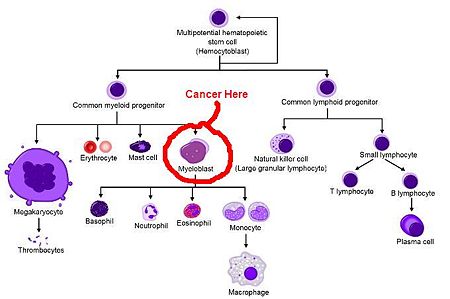Acute myeloid leukaemia
Definition
This is a cancer of myeloblasts.
This is not the same as myeloma. Confusingly, that is a cancer of plasma cells which, even more confusingly, are part of lymphoid line of cells. It actually has little to do with all the myeloblastic cells. The picture hopefully explains it more fully.
Epidemiology
![]() It's common amongst the haematological cancer and is really important to know about because it can kill you. About 90% of sufferers are adults and the incidence increases with age (63 being a rough median).
It's common amongst the haematological cancer and is really important to know about because it can kill you. About 90% of sufferers are adults and the incidence increases with age (63 being a rough median).
Pathophysiology
As mentioned above, AML is a cancer of the myeloblasts. The myeloblast stops maturing and is released into the blood in a state of "arrested development". As such, in AML, people have high levels of blast cells in their blood. What makes life more complicated is that the arrest in development can occur at any point. As such, AML is classified M0-M7. It's probably not worth learning all those but if you really want to see it, go here.
The problems of leukaemia stem from the white blood cells which myeloblasts mature into stop being produced.
Risk Factors
10-20% are caused by previous chemotherapy. Men are slightly more likely to get it. Having previous chronic myeloid leukamia, a myelodysplastic syndrome, and any of the following are all risk factors: aplastic anaemia, myelofibrosis, paroxysmal nocturnal haemoglobinuria and polycythaemia rubra vera.
Clinical Features
Children and young adults present over days-to-weeks whereas older people present of weeks-to-months
- Fever - neutropenia causes easy infection
- Bleeding - usually due to thrombocytopenia
- Hepatosplenomegaly - lymphadenopathy is less common
- Loss of appetite
- Bone pain
- Infection - including pneumonia
- Pallor
- Petechiae
- Leucostasis is an emergency with an incredibly high WBC (>100,000 cells/L) and results in:
- Respiratory distress
- Altered mental status
It's also possible for older people to present with angina or myocardial infarction, particularly if they already suffer from CHD.
Investigations
- FBC - anaemia, platelets↓, neutrophils↓, presence of blast cells
- Clotting screen - prothrombin time↑, fibrinogen↓, fibrin degradation products (FDP) present
- Lactate dehydrogenase↑
- Uric acid↑ (sometimes)
- LFTs and U+Es should be done before chemotherapy
- Bone marrow biopsy is diagnostic - >30% blast cells
- CXR, ECG, Multiple Gated Acquisition (MUGA) scan cardiac problems
Management
Basially it's split into two stage: induction (attaining remission) and consolidation (after remission, aka intenstification).
Induction
This stage of chemotherapy is incredibly intense. The idea is to destroy the majority of leukaemia cells. In terms of remission rates:
- over 60s - 50%
- adults under 60 - 70-80%
- children - 90%
Consolidation
The goal of this is to destroy remaining leukaemia cells. Commonly used agenst include daunorubicin, mitoxantrone and arabinosylcytosine. This can also involve bone marrow transplant. This can be autologous or allogenic. Autologous transplant involves extracting a patient's own healthy haematopoietic stem cells, freezing them and then transplanting them after chemo. Allogenic transplant involves using donor stem cells - this has the problem of having to find a match and the possibility of the recipient's body rejecting the cells.
Prognosis
In adults prognosis worsens with age. 60-70% acheive remission and there is a 15-25% 3-year survival rate. Children generally do better - 75-90% acheive remission and there is a 50% 5-year survival rate. If a suitable transplant donor can be found, 60-70% will have long-term remission or cure.
